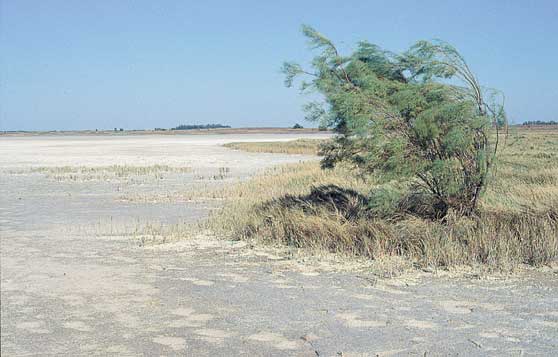Kansas Geological Survey, Public Information Circular (PIC) 21
![]()
![]()
![]()
![]()
Kansas Geological Survey, Public Information Circular (PIC) 21
Salty surface waters and salt flats at Big and Little Salt marshes at Quivira National Wildlife Refuge in Stafford County are caused by natural saltwater in the underlying bedrock. The Quivira marshes and the surrounding area are a common discharge center (an area where ground water moves upwards toward the surface), where freshwater and saltwater aquifers converge. The surface is capped by a veneer of wind-blown dune sand.
Water is a universal solvent, dissolving and chemically reacting with the rock formations it encounters. The longer water remains in the aquifer and the greater the distance it travels, the more mineralized it becomes (if soluble minerals, such as halite, are present). Salinity at Quivira is not related to the Hutchinson Salt Member (which underlies this area); instead, salinity here is related to the Cedar Hills Sandstone, and sandstone layers in the Salt Plain Formation (see fig. 2) which lie above the Hutchinson salt. These rocks contain salt minerals-halite (or common table salt) and anhydrite (a mineral similar to gypsum). The Cedar Hills Sandstone aquifer is recharged in southwest Kansas. Regional ground-water flow carries this water, which becomes increasingly saline, in an easterly direction until it discharges near the surface into the overlying freshwater aquifer west of the Quivira marshes. A north-south-trending ridge of Permian bedrock below the marshes restricts the easterly movement of ground water toward the Arkansas River and forces saltwater to discharge into the low-lying streams and marshes.
Salt concentrations are further increased at the surface by evaporation. The average salinity of Little Salt Marsh is approximately 2,500 parts per million (ppm) chloride, whereas that of Big Salt Marsh ranges from 5,000 to 10,000 ppm (sea water averages 19,000 ppm chloride, and drinking water about 250 ppm).
The Quivira marshes are characterized by poor drainage, springs and seeps with high salt concentrations, and salt-tolerant vegetation. Evaporation of shallow lakes concentrates salts on the bare ground, creating the white salt flats characteristic of the salt marsh.
Salt flats at Big Marsh, Quivira National Wildlife Refuge.

Kansas Geological Survey, Geology Extension
Web version July 2002
http://www.kgs.ku.edu/Publications/pic21/Quivira.html